Sarah Everard timeline: from when she went missing to murder, vigil, funeral and Wayne Couzens conviction
This article contains affiliate links. We may earn a small commission on items purchased through this article, but that does not affect our editorial judgement.
and live on Freeview channel 276
On 3 March 2021, Sarah Everard was murdered and the story of her death touched the nation.
The 33-year-old was kidnapped, raped and murdered by serving Metropolitan police officer Wayne Couzens.
Advertisement
Hide AdAdvertisement
Hide AdSarah’s murder at the hands of Couzens led to an outpouring of anger from the nation over violence against women.
Here’s the timeline of the pivotal events which happened before and after Sarah’s murder.
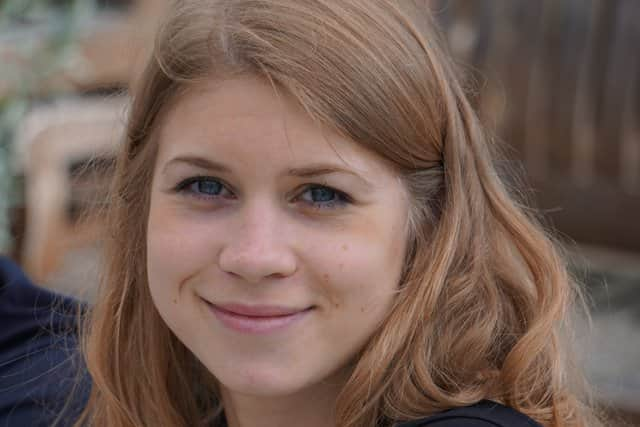

3 March
Sarah was first seen after leaving a friend’s house in Clapham at around 9pm on 3 March.
She was pictured on CCTV visiting a shop and again while she was traveling to her Brixton home on foot.
Advertisement
Hide AdAdvertisement
Hide AdAt around 9.30pm, Wayne Couzens, a police officer who was on leave at the time, pulled his hire car up to Poynders Road and falsely arrested Sarah for breaching Covid restrictions.
Around two hours later, Couzens arrived in Dover, Kent, with Sarah before they moved to his own car and drove to a secluded area.
It was at this point that Couzens brutally raped and murdered her.
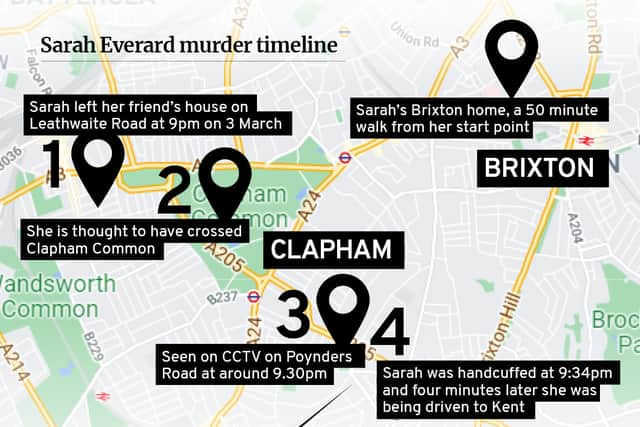

4 March
Before dawn of 4 March, CCTV caught Couzens driving near Hoad’s Wood in Ashford.
Advertisement
Hide AdAdvertisement
Hide AdLater that morning, at around 8.30am, he returned the hire car which he had initially used to pick up Sarah.
He disposed of her mobile in a stream in Sandwich at 9.30am.
Later that evening, Sarah’s boyfriend reported her as missing.
5 March
On 5 March, Couzens was seen buying petrol at a Whitfield petrol station, which was later found to be the fuel he used to burn Sarah’s body and possessions.
Advertisement
Hide AdAdvertisement
Hide AdHe set alight her body and possessions in Hoad’s Wood at 12.45pm, before buying rubble bags at B&Q which he used to transport her remains.
He dumped her remains in a nearby pond.
6 March
The Metropolitan Police launched a missing persons appeal for Sarah on 6 March.
Posters were distributed across London and a media campaign was launched to find Sarah.
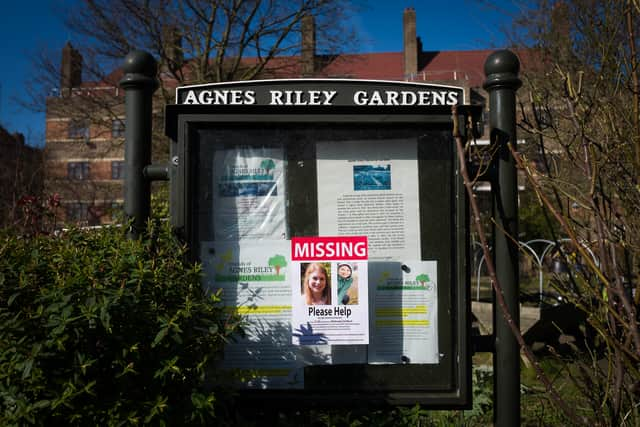

7 March
Three days after Sarah was first reported missing, police officers passed her case onto the Specialist Crime Command.
Advertisement
Hide AdAdvertisement
Hide AdFootage of the 33-year-old from a camera doorbell was also released to the public to aid the investigation.
On the same day, Couzens travelled to Hoad’s Wood with his wife and two children on a family trip.
8 March
Couzens was due to return to work on 8 March after a period of leave, however he called in sick.
The Specialist Crime Command Unit continue with their investigation and make progress after receiving information from 120 members of the public.
Advertisement
Hide AdAdvertisement
Hide Ad9 March
Following the investigation, police officers pinpoint Couzens as Sarah’s murderer and arrive at his home in Deal, Kent to arrest him.
At this point, Couzens had wiped his phone and tells officers that he does not recognise Sarah.
However, after being questioned by officers, he admits that he had met her but provides a false story about being blackmailed by an eastern European gang to abduct Sarah.
10 March
Wayne Couzens was publicly named after Scotland Yard confirmed a serving police officer was arrested in connection with Sarah’s murder.
Advertisement
Hide AdAdvertisement
Hide AdLater that afternoon, police found human remains in Hoad’s Wood, however they were not formally identified at that point.
11 March
Ahead of formal police interviews, Couzens purposely hits his head on a toilet bowl and is treated in hospital.
When police try to talk to him, he refused to answer any questions.
It is at this point the serving officer’s past record is examined, with the Independent Office for Police Conduct (IOPC) launching an investigation into whether a previous report of indecent exposure was handled correctly.
Advertisement
Hide AdAdvertisement
Hide Ad12 March
After formal identification, police confirmed the remains found in Hoad’s Wood were that of Sarah.
Three days after he was first arrested, Couzens was formally charged with the murder and kidnap of Sarah Everard.
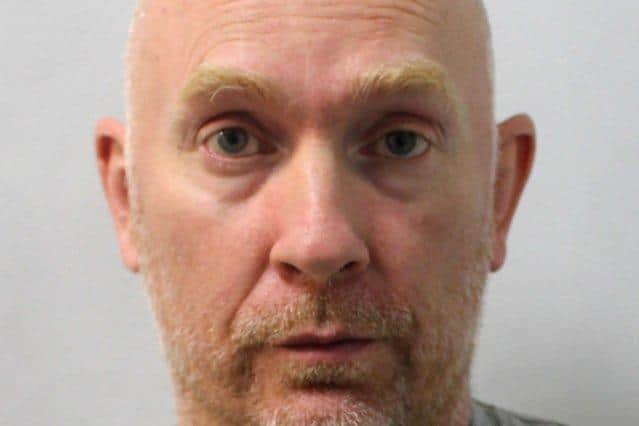

He was also taken to hospital once again after sustaining another head injury.
The IOPC expand its investigation into Couzens after receiving a second report of indecent exposure.
Advertisement
Hide AdAdvertisement
Hide Ad13 March
Couzens appeared at Westminster Magistrates’ Court on 13 March where he was remanded in custody at Belmarsh high-security prison in south London.
Later that evening, a large vigil took place on Clapham Common.


Women from all over, some who knew Sarah and other who did not, gathered to honour the young woman’s life and demonstrate against violence against women.
A large number of police officers were also in attendance.
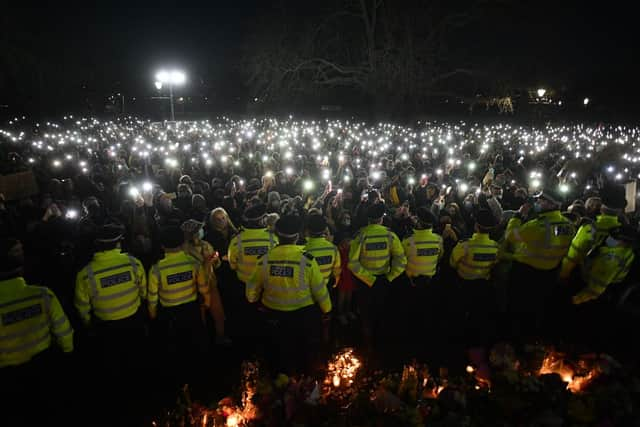

Among those to pay their respects to Sarah included the Duchess of Cambridge, who laid flowers at the pavillion.
Advertisement
Hide AdAdvertisement
Hide AdSarah’s death highlighted the #ReclaimTheStreets campaign, which was prominent at the vigil.
The campaign aims to make streets safer for women.
The vigil continues into the evening, with hundreds of people attending.
Nine arrests are made, leading to severe criticism of the Metropolitan Police and their behaviour towards the vigil.
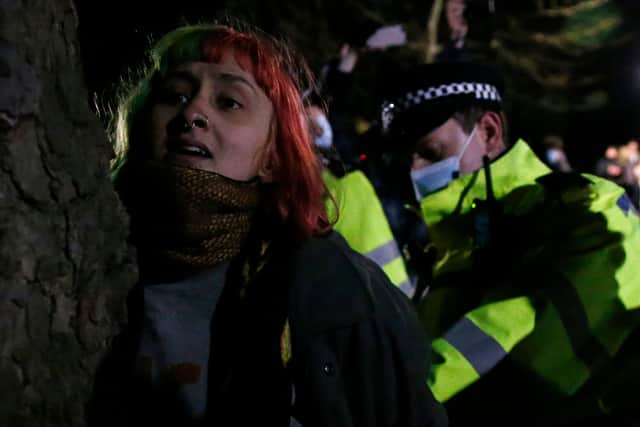

14 March
The fallout from the vigil continued as protests break out in Westminster criticising the Met Police’s handling of the vigil.
Advertisement
Hide AdAdvertisement
Hide AdOthers also used the protests to demonstrate against the Police, Crime, Sentencing and Courts Bill, which restricts the rights of protesters.
Across these protests, seven arrests were made.
16 March
Couzens appeared via video link at the Old Bailey.
He only spoke to confirm his name and date of birth, and was seen to have a wound on his head.
18 March
An inquest into Sarah’s death is opened and her body was released to her family for her funeral.
30 March
Following an internal investigation, The Met Police released findings that officers acted appropriately at the vigil on 13 March.
Advertisement
Hide AdAdvertisement
Hide AdHome secretary Priti Patel, who launched the investigation, said apparent violence directed towards officers was “simply unacceptable”, adding that people should not “prejudge the police” based on picture and videos from the vigil because “images can be taken out of context”.


The news was met with anger by those who were in attendance, including the organisers who said the findings would lead the Met Police trying to “regain that trust” of women over several years.
The findings were also criticised by other politicians, such as Lib Dems leader Sir Ed Davey, who was among those calling for the resignation of Met Police commissioner Cressida Dick.
1 June
Around three months after her death, a post mortem concludes Sarah died from compression of the neck.
Advertisement
Hide AdAdvertisement
Hide Ad8 June
While appearing at the Old Bailey, Couzens pleads guilty to the kidnap and rape of Sarah Everard.
The court also heard he accepted responsibility for her death.
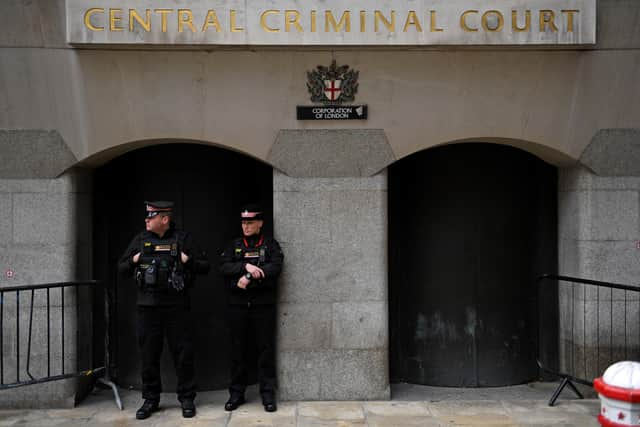

9 July
Around one month later, Couzens pleads guilty to the murder of Sarah.
16 July
The Met Police formally dismissed Couzens from the force, more than four months after Sarah’s murder.
Advertisement
Hide AdAdvertisement
Hide AdThe announcement comes after the conclusion of a misconduct hearing.
21 July
On 21 July, the Home Office launched a new taskforce to tackle violence against women and girls.
This included a launch of a new online tool ‘StreetSafe’, as well as tougher sentencing.
30 September
After a two-day hearing at the Old Bailey, Couzens was handed a whole-life sentence for the kidnap, rape and murder of Sarah Everard.
Advertisement
Hide AdAdvertisement
Hide AdLord Justice Fulford said during the trial Couzens had shown “no genuine contrition” for his crimes.
14 October
The case of Sarah Everard sparked widespread conversation about the safety of women.
Former police commissioner for North Yorkshire, Philip Allott, came under fire for comments he made when asked about the issue.
He said women needed to be “streetwise” and urged them to learn about the powers of arrest.
Advertisement
Hide AdAdvertisement
Hide AdMr Allott resigned from his post following an outpouring of anger stemming from his comments.
22 October
The IOPC bring misconduct proceedings against five serving officers following an investigation into social media messages sent and received by Couzens during his time in the force.
27 October
A month after his sentencing, Couzens appeals his whole-life sentence.
It was noted that a whole-life sentence has never been given for a single murder where terrorism is not involved.
Advertisement
Hide AdAdvertisement
Hide Ad22 November
Home secretary Priti Patel announced Dame Elish Angiolini QC would chair an independent investigation into Sarah’s murder and Couzens’ conduct during his policing career.
The first part of the report is due in 2022.
19 January, 2022
Legal proceedings are brought against the Met Police at the High Court by the organisers of the Clapham Common vigil.
The Reclaim These Streets campaign group alleges that officers breached human rights during their policing of the event, however the Met Police deny these claims.
1 February, 2022
Following the investigation by the IOPC, three officers are charged in connection with the sharing of grossly offensive messages with Couzens.
Advertisement
Hide AdAdvertisement
Hide AdPC Jonathan Cobban, PC William Neville and former constable Joel Borders are those accused of sharing the messages.
Two of the men who are still serving have been put on restricted duties.
A spokesperson for the Met Police said: “We are keenly aware that the events following Sarah Everard’s death have rocked the public’s faith in us, and we know that we have to work hard and make real changes in order to earn back that trust.”
A message from the editor:
Thank you for reading. NationalWorld is a new national news brand, produced by a team of journalists, editors, video producers and designers who live and work across the UK. Find out more about who’s who in the team, and our editorial values. We want to start a community among our readers, so please follow us on Facebook, Twitter and Instagram, and keep the conversation going. You can also sign up to our email newsletters and get a curated selection of our best reads to your inbox every day.
Comment Guidelines
National World encourages reader discussion on our stories. User feedback, insights and back-and-forth exchanges add a rich layer of context to reporting. Please review our Community Guidelines before commenting.
